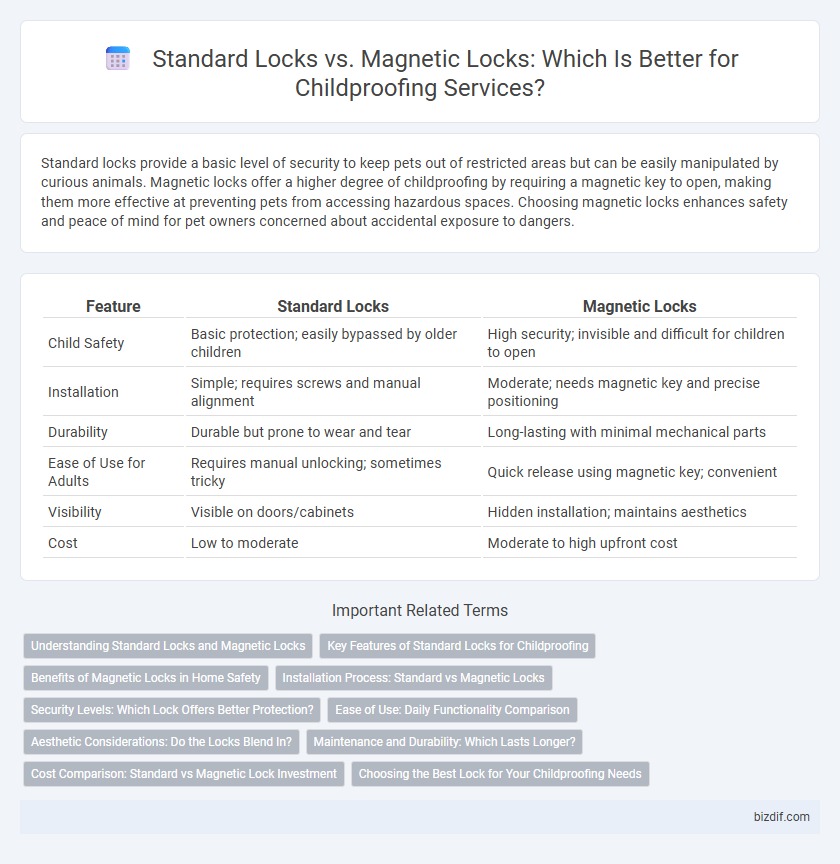Standard locks provide a basic level of security to keep pets out of restricted areas but can be easily manipulated by curious animals. Magnetic locks offer a higher degree of childproofing by requiring a magnetic key to open, making them more effective at preventing pets from accessing hazardous spaces. Choosing magnetic locks enhances safety and peace of mind for pet owners concerned about accidental exposure to dangers.
Table of Comparison
| Feature | Standard Locks | Magnetic Locks |
|---|---|---|
| Child Safety | Basic protection; easily bypassed by older children | High security; invisible and difficult for children to open |
| Installation | Simple; requires screws and manual alignment | Moderate; needs magnetic key and precise positioning |
| Durability | Durable but prone to wear and tear | Long-lasting with minimal mechanical parts |
| Ease of Use for Adults | Requires manual unlocking; sometimes tricky | Quick release using magnetic key; convenient |
| Visibility | Visible on doors/cabinets | Hidden installation; maintains aesthetics |
| Cost | Low to moderate | Moderate to high upfront cost |
Understanding Standard Locks and Magnetic Locks
Standard locks use mechanical keys or combination codes to secure cabinets and doors, providing straightforward childproofing solutions that are easily installed and affordable. Magnetic locks rely on hidden mechanisms unlocked only with a magnetic key, offering a discreet and tamper-resistant option ideal for keeping children away from hazardous areas. Choosing between standard and magnetic locks depends on the level of security needed, aesthetic preferences, and ease of adult access while ensuring maximum safety for children.
Key Features of Standard Locks for Childproofing
Standard locks for childproofing feature mechanical latching mechanisms that require manual engagement to secure cabinets and drawers, providing reliable physical barriers against child access. These locks often include adjustable straps, pressure-mounted designs, and simple push-button systems, enabling easy installation without tools and compatibility with various furniture types. Their durable construction ensures long-lasting protection, effectively preventing accidental injury by restricting access to hazardous items like cleaning supplies and sharp objects.
Benefits of Magnetic Locks in Home Safety
Magnetic locks provide enhanced home safety by offering keyless, tamper-resistant security that is difficult for children to open, reducing accidental access to hazardous areas. Their concealed installation preserves cabinet aesthetics while maintaining strong locking mechanisms that outperform standard locks prone to wear and easy manipulation. These locks also simplify parental control and increase durability, ensuring long-term protection in childproofing efforts.
Installation Process: Standard vs Magnetic Locks
Standard locks require drilling into doors or cabinets and securing with screws, which can be time-consuming and may damage surfaces. Magnetic locks install with adhesive pads or screws, offering a faster, less invasive setup ideal for renters or temporary childproofing. Magnetic lock installation typically involves aligning hidden components for seamless functionality, whereas standard locks need visible hardware placement for manual operation.
Security Levels: Which Lock Offers Better Protection?
Standard locks provide traditional mechanical security with visible locking mechanisms that are often easier to pick or force open, making them less ideal for high-risk childproofing areas. Magnetic locks use concealed electronic components activated by a magnetic key, offering superior protection by preventing unauthorized access with no exposed hardware. Their advanced technology significantly reduces the risk of children bypassing the lock, delivering a higher security level in childproofing applications.
Ease of Use: Daily Functionality Comparison
Standard locks offer straightforward operation with familiar turning or pressing mechanisms, facilitating quick daily access without requiring additional tools or complicated steps. Magnetic locks provide enhanced security with touchless activation, yet they may involve more complex installation and occasional battery maintenance that can affect ease of use. Choosing between standard and magnetic locks depends on balancing convenience in everyday handling versus the need for heightened childproofing security features.
Aesthetic Considerations: Do the Locks Blend In?
Standard locks typically feature visible mechanical components that can disrupt a room's design flow, often requiring bulky hardware that contrasts with modern aesthetics. Magnetic locks, installed discreetly inside cabinets or drawers, remain virtually invisible and help maintain a clean, streamlined look ideal for contemporary interiors. Choosing magnetic locks enhances child safety without compromising the visual harmony of home decor.
Maintenance and Durability: Which Lasts Longer?
Standard locks offer robust mechanical components that require occasional lubrication to maintain smooth operation, ensuring long-term durability with minimal maintenance. Magnetic locks rely on electronic components and batteries, which demand regular checks and replacements, potentially reducing their lifespan under heavy use. For childproofing, standard locks generally last longer due to their simpler design and fewer maintenance needs, providing reliable safety over time.
Cost Comparison: Standard vs Magnetic Lock Investment
Standard locks for childproofing typically cost between $5 and $15 per unit, making them a budget-friendly option for securing cabinets and drawers. Magnetic locks, while more expensive, ranging from $20 to $40 each, offer enhanced security and invisibility, reducing tampering risk by children. The higher initial investment in magnetic locks often translates into longer-term durability and fewer replacements compared to standard locks.
Choosing the Best Lock for Your Childproofing Needs
Standard locks offer reliable mechanical security and are often easier to install and operate, making them a practical choice for everyday childproofing. Magnetic locks provide enhanced safety by being hidden and tamper-resistant, requiring a magnetic key that prevents children from accessing cabinets or doors. Selecting the best lock depends on balancing ease of use, security level, and specific areas needing protection in your home.
Standard locks vs Magnetic locks Infographic

 bizdif.com
bizdif.com